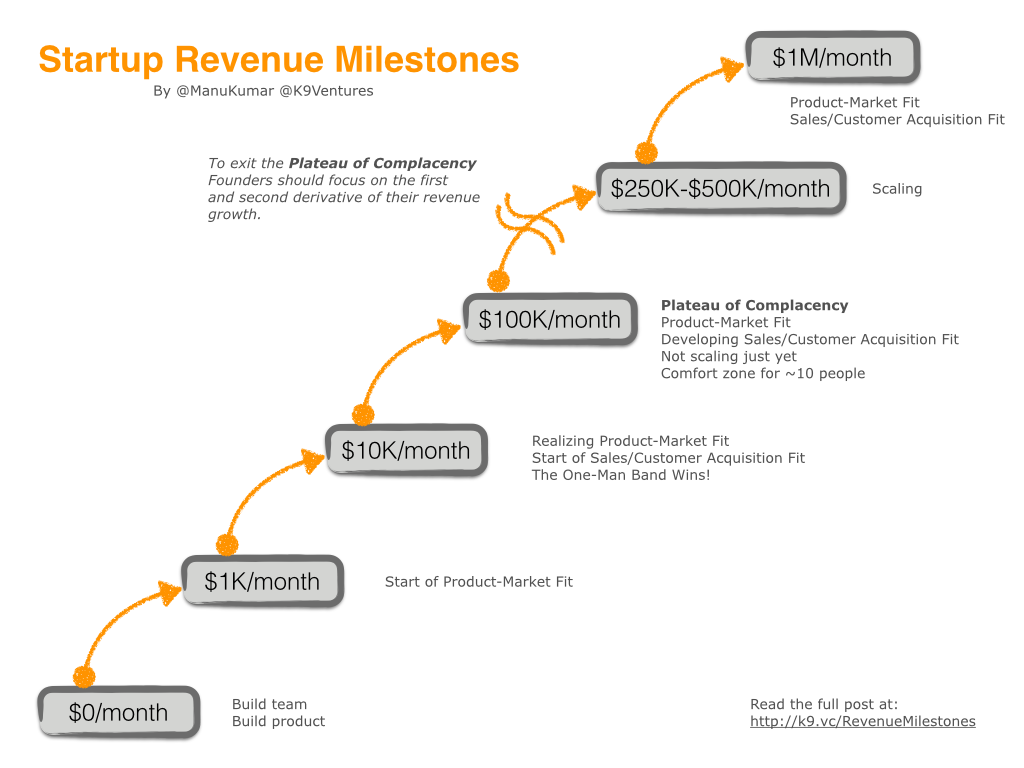At K9 we invest in companies which have a clear/direct revenue model and typically don’t invest in companies that follow the Ubiquity first Revenue Later (URL) revenue model made famous by Eric Schmidt in 2007. In my discussions with K9 portfolio founders about scaling revenue, I very often end up drawing the same picture:
$0/month
When a startup is just getting started it first needs to build its product/service. Often before that it needs to build the team that will then help to build the product/service. And in order to do that they need to either raise capital to be able to hire a team by paying them real dollars or recruit co-founders who are willing to share the journey based on the equity stake and bootstrap the company.
Once a startup has its initial product, or even a minimum viable product, it needs to start iterating on its revenue model the same way that it iterates on its product. I call this Revenue Development and have written about it before. The purpose of this post is to provide some clear milestones for process of revenue development. If you haven’t already read the post on Revenue Development, I’d recommend you read that first and then come back and continue reading from here.
Note: The dollar numbers I’m using in this post are for illustrative purposes only. You should know what numbers make sense for your business. If you’re selling a product that costs six figures or seven figures, then obviously your thresholds may be very different. For the purposes of this example, I’m assuming a company where the price point for the product or service is in tens or hundreds of dollars.
>$0/month
For most startups going from no revenue to their first paying customer is a major milestone. At this point you’ve convinced at least one person that you’re doing something that provides them value and therefore they are willing to pay for it. While this is a key milestone it is only the base step of a much longer inductive process. Once you have one customer, you have to then try and find another person who thinks just like the previous one and is willing to become your second customer.
Once you have a handful of customers you need to then figure out what’s the pattern that makes the process repeatable. Why did the customers buy your product? How much would they have paid for it? Was price an issue? Would they have bought it more quickly if it was priced lower? Would they have bought it even if it was priced higher? Are your customers happy? Will they continue using your product? Would they refer other people to you or at least serve as a reference?
$1K/month
The first meaningful revenue milestone is for a company to get to $1,000 per month in revenue. By this point the company should have built a product that people want and are willing to pay for. But they may not have figured out the sales model just yet. At this point you’ve started to see the tip of the iceberg of product market fit.
$10K/month
The next major milestone that a startup should try to hit is to get to $10,000 per month in revenue. The $10K per month in revenue milestone means that you’re well on your way to product market fit and you’re just beginning to figure out what the sales process looks like. At $10K/month, it’s also a meaningful number as now you’re at least covering the cost of 1 full-time person. If you were a one-man-band then heck you may already be cashflow positive and profitable, but that’s rarely the case in most startups.

$100K/month
One of my favorite people to work with as a co-investor is Ann Miura-Ko from Floodgate. Ann and I had the pleasure of working with Lyft in its early days and one of the questions that Ann would ask Logan and John often was: “When do you get to $100K/month in revenue?”
Getting to the $100K/month in revenue is a big event in a startup’s life. That’s real money. And it’s real money to cover not just a 1 person team, but maybe a 10 person team! And it means that you definitely have good product market fit. It also means that you’ve figured out how to acquire customers. Congrats. You made it. Right?
Not so fast. I refer to the $100K/month level of revenue as the Plateau of Complacency. Getting to this point was hard freaking work. You busted your ass to get here and you deserve all the credit for it.
The danger, however, is that you’re now a company with real revenue. You’re past the stage of potentially an existential crisis. By carefully managing your burn rate and steadily growing revenue, you can now survive — almost forever. But there-in lies the rub. When a company reaches this level, the founders are often tired and want and need a well deserved break.
Growing revenue to a multiple beyond $100K requires a *lot* more potential energy than almost at any other stage of the company. At the beginning, when you have no revenue, you’re driven by an existential crisis and are fighting for survival. But when you have $100K+/month in revenue, you’re almost afraid of breaking something that’s working and that you’ve worked very hard to build.
I’ve seen too many company fall victim to the plateau of complacency. It’s easy for the founders to give in to this because they can see a steady but linear increase in the revenue each month. Last month we did $100K, this month we did $105K, next month we did $110K. So it feels like they’re steadily increasing their revenue, keeping the operations running and things are going well. However, they’ve now fallen into the plateau of complacency, because unless they do something radical they won’t be able to get to the next level.
My advice to founders when they’re at this stage is to stop looking at the absolute growth in revenue and start looking at the first derivative of the revenue — what the rate of change of the revenue. and also look at the second derivative to see if that rate of change of the revenue is accelerating or decelerating. The mathematical analogy hopefully works well for technical founders, but the concept is pretty simple: If you start looking at the rate of change, then you’re more likely to realize that you need to do something radical — almost a leap of faith to take you to the next level.
$250–500K/month
In my example so far, I’ve talked about 10X-ing revenue to get to each milestone from $1K/month to $10K/month to $100K/mo. Since leveling up from the $100K/month level is so difficult, it’s highly unlikely for a startup to go from $100K/month to $1M/month in revenue. Instead the company needs an intermediate goal of getting to $250K/month in revenue or getting to $500K/month in revenue.
The stage of getting from $100K/month to $500K/month is probably one of the toughest phases in the life of company. At this point it is not big enough to hire experienced (read expensive) people and turn up it’s burn rate to where it can then crater. You have to find the right mindset of people who may not have direct experience but have the right DNA and the desire to learn, the desire to execute and prove themselves — they themselves want to level up.
It is only possible to get to $250K/month or $500K/month in revenue once you absolutely have product market fit nailed. You have developed a clear and repeatable sales process. And you’ve figure out how to make your customers fans by delivering a quality of product or service that is awesome. Additionally, internally your team needs to scale and not fall victim to internal politics and finger pointing. You need to be paying attention to recruiting, technology / product, manufacturing, operations, finance, marketing, sales, customer support and more. Note that the first item on that list for me is recruiting. If you’re going to grow different areas of the company you need to be able to hire scalably, while maintaining the quality of the people you’re hiring.
$1M/month
Once you cross the hurdle of $100K/month and start getting to $500K/month in revenue, then growing from there $1M/month in revenue is simpler. As by this point you’ve most likely figured out what works and you probably have a team that’s gelling well. Now you need to just do more of it to get to $1M/month in revenue.
If you’re a founding CEO, think about where your company is along this spectrum of startup revenue milestones and think about what you need to do to get to the next level. And don’t forget to look at the first and second derivative of your revenue growth. Good luck!
You can follow me on @Twitter at @ManuKumar, and for all things @K9Ventures K9 Ventures is also on Facebook and Google+.



